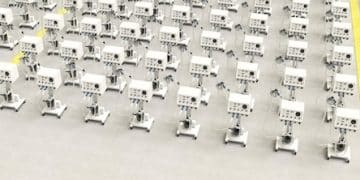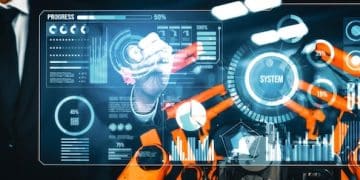US Labor Market: Bridging Skills Gap & Addressing Workforce Shortages

Labor market trends in the US reveal a critical need to address the skills gap and workforce shortages through strategic initiatives like upskilling, reskilling, and fostering partnerships between educational institutions and industries.
Navigating the complexities of the US labor market requires a keen understanding of current labor market trends, navigating the skills gap and workforce shortages in the US. Businesses and individuals alike must adapt to these shifts to ensure continued success and competitiveness.
Understanding the Current State of the US Labor Market
The US labor market is currently experiencing a period of dynamic change, characterized by a persistent skills gap and significant workforce shortages. Understanding these challenges is crucial for developing effective strategies to address them and ensure sustainable economic growth.
Factors Contributing to the Skills Gap
Several factors contribute to the widening skills gap in the US. These include rapid technological advancements, changing industry needs, and a mismatch between the skills possessed by the workforce and those demanded by employers.
- Rapid Technological Change: Automation and artificial intelligence are transforming industries, requiring workers to acquire new technical skills.
- Evolving Industry Needs: As industries evolve, the demand for specific skills shifts, leaving some workers behind.
- Mismatch Between Education and Jobs: Educational programs may not always align with the current needs of the labor market, creating a gap between available jobs and qualified candidates.

To bridge this gap, there needs to be a greater emphasis on vocational training and continuing education programs that equip workers with the skills they need to succeed in today’s economy. Furthermore, fostering closer collaboration between educational institutions and employers can help ensure that curriculums are relevant and responsive to the needs of the labor market.
The Impact of Workforce Shortages on US Industries
Workforce shortages are significantly impacting various industries across the US, leading to production bottlenecks, increased labor costs, and reduced overall productivity. Addressing these shortages is essential for maintaining economic competitiveness and stability.
Industries Most Affected by Shortages
Several sectors are particularly hard-hit by workforce shortages, including healthcare, manufacturing, and technology. These industries require specialized skills and face challenges in attracting and retaining qualified workers.
- Healthcare: Aging population and increased demand for healthcare services have led to shortages of nurses, doctors, and other healthcare professionals.
- Manufacturing: A lack of skilled tradespeople, such as machinists and welders, is hindering the growth of the manufacturing sector.
- Technology: Rapid innovation in technology has created a high demand for software developers, data scientists, and cybersecurity experts.
The implications of these shortages are far-reaching, affecting not only businesses but also consumers and the overall economy. Addressing workforce shortages requires a multi-pronged approach, including improving recruitment strategies, enhancing employee retention efforts, and investing in training and development programs.
Strategies for Navigating the Skills Gap
Effectively navigating the skills gap requires a proactive approach that involves upskilling, reskilling, and fostering partnerships between businesses, educational institutions, and government agencies. This collaborative effort is essential for ensuring that the workforce has the skills needed to meet the demands of the modern economy.
Upskilling and Reskilling Initiatives
Upskilling involves enhancing the skills of current employees to improve their performance and productivity, while reskilling focuses on providing workers with entirely new skills to transition to different roles or industries.
Investing in upskilling and reskilling initiatives can benefit both employers and employees by improving job satisfaction, increasing productivity, and reducing turnover. These initiatives can take various forms, including on-the-job training, online courses, and mentorship programs.
The Role of Education and Training Programs
Education and training programs play a crucial role in preparing workers for the demands of the labor market. These programs should be designed to align with industry needs and provide students with practical, hands-on experience.
- Curriculum Development: Educational institutions should continuously update their curriculums to reflect the latest industry trends and technologies.
- Apprenticeships and Internships: Offering apprenticeships and internships provides students with valuable real-world experience and helps them develop the skills employers are looking for.
- Partnerships with Businesses: Collaborative partnerships between educational institutions and businesses can help ensure that training programs are relevant and effective.
By working together, educational institutions and businesses can create a pipeline of skilled workers who are ready to meet the challenges of the modern economy. This collaboration is essential for addressing the skills gap and ensuring the long-term competitiveness of the US labor market.
Leveraging Technology to Address Workforce Shortages
Technology can play a significant role in addressing workforce shortages by improving recruitment processes, enhancing employee training, and increasing productivity. Embracing technological innovations is essential for businesses looking to overcome the challenges posed by a tight labor market.
Automation and AI in the Workplace
Automation and artificial intelligence (AI) can help alleviate workforce shortages by automating repetitive tasks and freeing up employees to focus on higher-value activities. Implementing these technologies can improve efficiency and reduce the need for additional staff.
However, the adoption of automation and AI should be approached strategically, with a focus on augmenting human capabilities rather than replacing them entirely. This requires investing in training programs to equip workers with the skills they need to work alongside these new technologies.

Remote Work and Flexible Arrangements
Offering remote work and flexible work arrangements can help attract and retain talent by providing employees with greater autonomy and work-life balance. These arrangements can also expand the talent pool by allowing businesses to recruit workers from anywhere in the country.
To successfully implement remote work policies, businesses need to invest in the necessary technology and infrastructure, as well as establish clear communication protocols and performance metrics. This will ensure that remote workers are productive and engaged, contributing to the overall success of the organization.
Government Policies and Initiatives Supporting Workforce Development
Government policies and initiatives play a crucial role in supporting workforce development by providing funding for training programs, promoting apprenticeships, and addressing barriers to employment. These initiatives are essential for ensuring that all Americans have the opportunity to acquire the skills they need to succeed in the modern economy.
Funding for Training and Education Programs
Government funding for training and education programs helps to ensure that individuals have access to affordable and effective training opportunities. These programs can range from vocational training to community college courses to university degree programs.
By investing in these programs, the government can help to close the skills gap and create a more competitive workforce. This investment not only benefits individuals but also strengthens the overall economy by increasing productivity and innovation.
Promoting Apprenticeships and Vocational Training
Apprenticeships and vocational training programs provide individuals with hands-on experience and the skills they need to enter high-demand industries. These programs combine classroom instruction with on-the-job training, allowing participants to earn while they learn.
- Industry Partnerships: Government can foster partnerships between businesses and educational institutions to create apprenticeship programs that meet industry needs.
- Incentives for Employers: Providing incentives for employers to participate in apprenticeship programs can encourage greater adoption of this training model.
- Skills-Based Credentials: Recognizing skills-based credentials can help individuals demonstrate their competencies and gain access to employment opportunities.
These programs are particularly effective at addressing the skills gap in industries such as manufacturing, construction, and healthcare, where there is a high demand for skilled tradespeople.
The Future of Work: Preparing for Emerging Trends
The future of work will be shaped by emerging trends such as the gig economy, remote work, and the increasing importance of digital skills. Preparing for these trends is essential for businesses and workers alike to ensure continued success and competitiveness.
The Gig Economy and Freelance Work
The gig economy is characterized by short-term contracts and freelance work, offering workers greater flexibility and autonomy. While this can be appealing to some, it also presents challenges in terms of job security and benefits.
To thrive in the gig economy, workers need to develop strong self-marketing skills, as well as the ability to manage their finances and taxes. Businesses, in turn, need to adapt their hiring practices and compensation models to attract and retain gig workers.
The Importance of Digital Literacy
Digital literacy is becoming increasingly important in the modern workplace, as more and more jobs require the ability to use technology effectively. This includes not only basic computer skills but also the ability to use specialized software and online tools.
Investing in digital literacy training is essential for ensuring that workers have the skills they need to succeed in the digital economy. This training should be accessible to all, regardless of age, education level, or socioeconomic background.
By focusing on digital literacy, we can empower individuals to participate fully in the modern economy and contribute to the overall growth and prosperity of the nation.
| Key Point | Brief Description |
|---|---|
| 📈 Skills Gap | Mismatch between employer skill demands and available workforce skills. |
| 🧑🏭 Workforce Shortages | Insufficient workforce availability in key sectors like healthcare and manufacturing. |
| 🚀 Upskilling & Reskilling | Strategies to enhance existing skills or learn new ones for career transitions. |
| 🤖 Technology Adoption | Utilizing automation and AI to fill workforce gaps and increase efficiency. |
Frequently Asked Questions (FAQ)
▼
The skills gap refers to the discrepancy between the skills employers require and the skills that job seekers possess. This gap can lead to difficulties in filling open positions and reduced productivity.
▼
Healthcare, manufacturing, and technology are among the industries most severely affected by workforce shortages due to factors like an aging population, evolving skill requirements, and rapid technological advancements.
▼
Effective strategies include upskilling and reskilling initiatives, partnering with educational institutions to align curricula with industry needs, and promoting apprenticeships and vocational training programs.
▼
Technology solutions such as automation and AI can automate repetitive tasks, freeing up employees for higher-value activities. Remote work and flexible arrangements can also expand the talent pool.
▼
Government policies and initiatives support workforce development by providing funding for training programs, promoting apprenticeships, and addressing barriers to employment, ensuring a skilled and competitive workforce.
Conclusion
Addressing the labor market trends, navigating the skills gap and workforce shortages in the US, calls for coordinated efforts from businesses, educational institutions, and government bodies. By investing in upskilling, embracing technology, and implementing supportive policies, the US can build a robust and adaptable workforce capable of meeting the challenges of the future.





